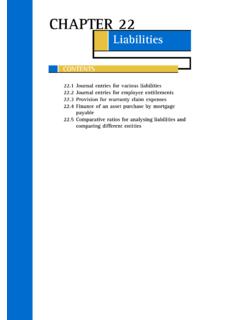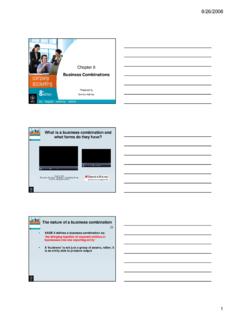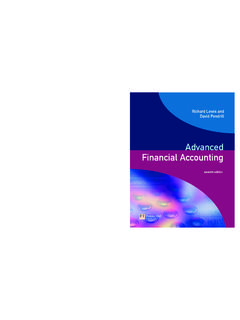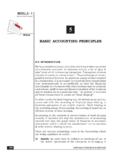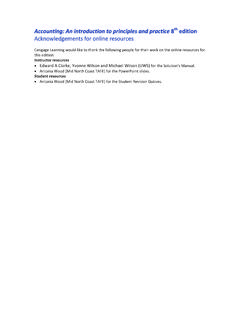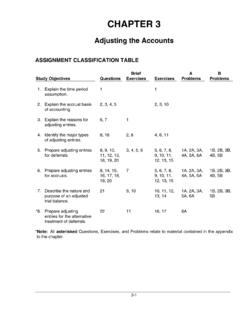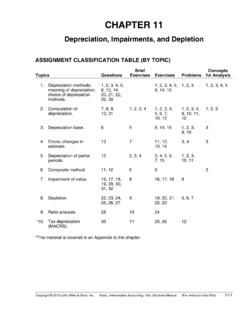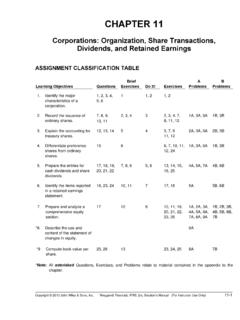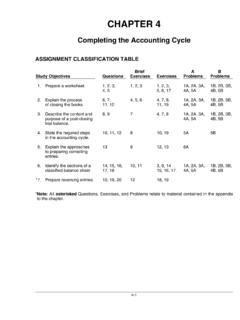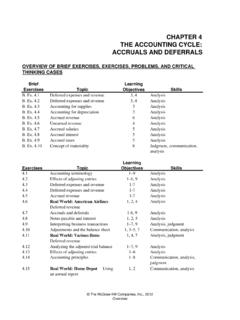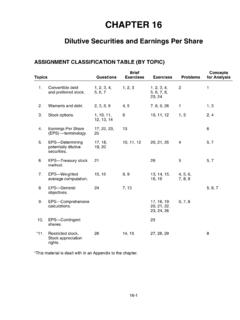Transcription of STUDY GUIDE Financial Accounting - John Wiley
1 6th editionFinancialAccountingSTUDY GUIDE TO ACCOMPANYH oggettEdwardsMedlinprepared by Allan DuffusSixth edition published 2006 by John Wiley & Sons Australia, Ltd 42 McDougall Street, Milton, Qld 4064 Offices also in Sydney and Melbourne John Wiley & Sons Australia, Ltd 1992, 1996, 2000, 2003, 2006 ISBN-13 978 0 470 80688 3. ISBN-10 0 470 80688 5. Typset in pt Times New Roman Reproduction and communication for educational purposes The Australian Copyright Act 1968 (the Act) allows a maximum of one chapter or 10% of the pages of this work, whichever is the greater, to be reproduced and/or communicated by any educational institution for its educational purposes provided that the educational institution (or the body that administers it) has given a remuneration notice to Copyright Agency Limited (CAL) under the Act.
2 For details of the CAL licence for educational institutions contact: Reproduction and communication for other purposes Except as permitted under the Act (for example, a fair dealing for the purposes of STUDY , research, criticism or review), no part of this book may be reproduced, stored in a retrieval system, communicated or transmitted in any form or by any means without prior written permission. All inquiries should be made to the publisher at the address above. Edited by Janette Whelan Publishing Consultancy Cover images: Getty Images/Stone/Paul Edmondson Printed in China by Printplus Limited 10 9 8 7 6 5 4 3 2 1 CONTENTS Chapter 1.
3 Decision making and the role of 1 2. Financial statements for decision making .. 11 3. Recording transactions .. 24 4. Adjusting the accounts and preparing Financial statements .. 43 5. Completing the Accounting cycle .. 61 6. Accounting for retailing .. 78 7. Accounting systems .. 96 8. Partnerships: formation, operation and 117 9. Partnerships: admission, retirement and dissolution .. 131 10. Companies: formation and operations .. 145 11. Regulation and the conceptual 161 12. Cash management and control.
4 177 13. Receivables .. 196 14. 215 15. Non-current assets: acquisition and 233 16. Non-current assets: revaluation, disposal and other aspects .. 249 17. Liabilities .. 268 18. Presentation of Financial 285 19. Cash flow statements .. 300 20. Analysis and interpretation of Financial statements .. 315 TO THE STUDENT About the STUDY GUIDE This STUDY GUIDE is a self- STUDY aid designed to complement the sixth edition of John Hoggett, Lew Edwards and John Medlin s Financial Accounting 6e. For each chapter in the textbook there is a corresponding chapter in the STUDY GUIDE .
5 Each chapter in the STUDY GUIDE begins with learning objectives and STUDY tips for the chapter. These are followed by a chapter review which takes each of the chapter learning objectives and summarises the significant points. At the end of each chapter is a section designed to test your knowledge of the chapter. Features of the sixth edition are a Knowledge checklist and a crossword designed to consolidate your conceptual understanding of the chapter and your understanding of the terminology introduced in the chapter.
6 Ten true/false statements, ten multiple-choice questions and four demonstration problems are also provided. Solutions to the crossword, and the answers to the true/false statements and the multiple-choice questions are included, as well as suggested solutions to the demonstration problems. How to use this STUDY GUIDE There are several effective STUDY methods or learning styles. The following suggestions may be useful. Approach the STUDY of each chapter with a spirit of learning. Some rules and procedures must be memorised.
7 However, rather than try to memorise all definitions, rules or procedures, develop a clear understanding of the main concepts and the logic of the procedures covered. After you have studied the textbook chapter thoroughly and worked your way through the illustrations, examine the learning objectives again. Ask yourself whether you know and understand them. If there is an objective you do not understand, go back and review related material in the textbook. Use the Knowledge checklist and the crossword to test how well you understand the concepts and procedures introduced in the chapter.
8 Then complete the Test your knowledge section of the STUDY GUIDE . Check your answers and solutions with those provided in the STUDY GUIDE only after you have completed the section. If you are still not confident that your answers compare favourably with the solutions provided, refer again to the appropriate material in the textbook and STUDY GUIDE . I wish you every success with your studies. Acknowledgements The author wishes to thank the following for their encouragement and assistance in the preparation of this sixth edition of the STUDY GUIDE : the staff at John Wiley & Sons Australia, Ltd, especially Susan Phillips for her liaison and assistance in publishing; and my wife, Marnie, for her encouragement and assistance in proofreading the final draft.
9 Any errors or omissions are the responsibility of the author. Feedback from lecturers and students in this regard to or would be appreciated. Allan J. Duffus, FCPA CHAPTER 1 Decision making and the role of Accounting TEXT REFERENCE: John Hoggett, Lew Edwards & John Medlin, Financial Accounting , 6th edn, 2006, chapter 1. OBJECTIVES When you have studied this chapter, you should be able to: 1. understand the nature of decisions and the decision-making process 2. appreciate the wide range of economic decisions made in the marketplace 3.
10 Explain the nature of Accounting and its main functions 4. identify the potential users of Accounting information 5. use information to make simple economic decisions 6. understand the role of Accounting information in the decision-making process 7. understand the differences between Accounting for management and Accounting for external users 8. understand how the Accounting profession is organised in Australia 9. identify the different areas of the economy in which accountants work 10. understand the importance of ethics in business and Accounting and how to recognise and handle ethical dilemmas as part of the decision-making process.


